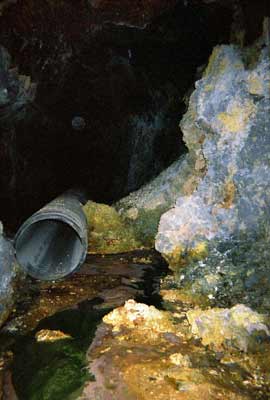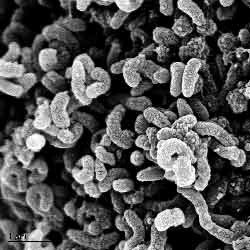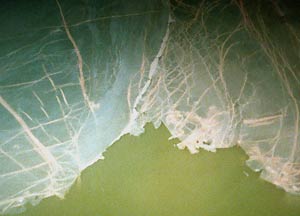UC Berkeley Press Release
Proteomics brings researchers closer to understanding microbes that produce acid mine drainage
BERKELEY – A pink, bacterial scum on the floor of an abandoned mine seems an unlikely place to study community development, but a biological breakthrough is allowing University of California, Berkeley, researchers to probe the give and take in this microbial mat.
 In an underground mine tunnel, green acid solutions flow across a bed of pyrite (fool's gold). Pink microbial biofilm communities can be seen along the margins of the stream. (Photo by Jill Banfield/UC Berkeley) |
Last year, the UC Berkeley team joined with the Department of Energy's Joint Genome Institute to pluck out the genomes of the five dominant bacteria in a slime, or biofilm, responsible for acidic drainage from the mine. Now, they have gone further and, with the help of colleagues at the DOE's Oak Ridge National Laboratory, identified the proteins that go with these five organisms, their so-called proteomes.
The technique they used is the first successful leveraging of a community genome to obtain the complete complement of proteins produced by that community of organisms, said team leader Jill Banfield, professor of earth and planetary science and of environmental science, policy and management at UC Berkeley.
This technique not only tells her and her colleagues what genes are expressed as proteins in each bacteria, but also how much of each is produced - the key to understanding the role each bacterial species plays in the biofilm community.
"Genomes tell you about the genetic potential of organisms that are present in the environment, what organisms might be able to do," said Banfield, a scientist at Lawrence Berkeley National Laboratory. "But you can't tell whether they are doing it or not. We want to go beyond the level of 'Can they?' to 'Are they?,' and the way we do that is go after some measure of gene expression."
Banfield and her colleagues at UC Berkeley, Oak Ridge National Laboratory (ORNL), Lawrence Livermore National Laboratory and Xavier University in New Orleans report their findings in a paper appearing May 5 on the Science Express Web site, an advance online publication of the journal Science.
 A scanning electron microscope image of a piece of biofilm shows that these microbial communities comprise a very tight association of microbial cells. The biofilms grow hundreds of feet underground in the absence of light and use iron and sulfur as energy sources. (Photo by Clara Chan/UC Berkeley) |
For some nine years, Banfield has been studying the microbial biofilm community at the Richmond Mine in Iron Mountain, Calif., nine miles northwest of Redding and one of the largest Superfund sites in the country. She hopes to understand how the organisms live together and interact with minerals to produce the hot, heavy-metal rich and highly acidic water that drains from the mine and contaminates surrounding streams. The film, which can form a tough sheet that is millimeters thick, sits atop green, 108 degree Fahrenheit runoff containing zinc, iron, copper and arsenic.
"This system is a very tightly coupled biogeochemical system, and we are just trying to find out how it works," she said.
"This microbial community is thriving at the extreme edge," added co-author Bob Hettich, a member of ORNL's Chemical Sciences Division. "A pH level of 0.8 is like swimming in sulfuric acid, so we'd like to know how this community can survive and how we might be able to use this information to better understand microbial systems in real-world conditions."
Bacteria, along with ancient microbes called Archaea, in the biofilm capture carbon and nitrogen from the atmosphere and derive energy from iron that has been leached out of the iron sulfide rock, also known as pyrite or "fool's gold." In the process, they produce sulfuric acid that leaches more iron from the pyrite and releases other heavy metals.
Last year's feat gave Banfield's team the nearly complete genomes of the five major bacteria in the biofilm, four of them new to science. The current study now provides nearly half the proteins predicted to be produced by the dominant bacteria, a Leptospirillum group II bacterium, and a smaller proportion from the other bacteria. The lesser coverage of the minor bacteria in the community is due in part because their genomes are more fragmented and in part because these bacteria are in lower concentrations, so their proteins are at correspondingly lower concentrations.
 The pink biofilm, a community of bacteria that thrives in an abandoned mine, floats atop green acidic drainage with a pH of about 0.8, which is equivalent to battery acid. (Photo by Jill Banfield/UC Berkeley) |
"We identified 48 percent of the products of the genes encoded by the genome of the dominant organism. That's at least as good as most people do with proteomics on single organisms growing in the laboratory," Banfield said. "The exciting thing to me is we can start to study the organisms in situ, and that's really a big step forward."
Of the 2,033 proteins detected, 572 were unique to the biofilm bacteria. One of the new proteins produced by the Leptospirillum group II bacterium appears to be a key protein in the production of acid mine drainage. The protein, a cytochrome, oxidizes iron, and thus controls the rate of production of acid mine drainage.
"This is how it gets its food, this is its mechanism for harvesting energy from the environment," said Banfield. "It's probably the first step in the electron transport chain associated with the metabolism of the organism."
Interestingly, many of the proteins produced by the biofilm bacteria are responsible for maintaining correctly folded proteins and defending against free radicals, "suggesting that these are significant challenges in this hot, acid environment," she said.
"One of the most interesting things we found is that there are large numbers of proteins that don't resemble any other proteins we know about. Many are enzymes that function to maintain the correct structure of other proteins that are exposed to the unusually harsh acidic environment," added Michael Thelen, a protein biochemist at Lawrence Livermore National Laboratory.
Last year's paper reporting the community genome showed that a minor organism in the community, a Leptospirillum group III bacterium, was responsible for a key function: fixing nitrogen from the atmosphere. The new proteome confirms that this is a keystone species in more ways than one.
"We were somewhat surprised to see that Leptospirillum group III, that same minor organism, is also taking a lion's share of the responsibility in producing the extracellular polymers that make the biofilm matrix upon which all community members depend," Banfield said. "It's like it's a slave."
The team also was able to identify important acid-stable proteins, including the iron oxidizing protein in Leptospirillum group II bacterium, that may have technological applications in the longer term, Banfield said.
The "proteogenomic" technique Banfield and her team used to extract the proteome from the biofilm involved dicing up all the proteins in a melange of the organisms, then determining at ORNL the masses of these short proteins, called peptides, with "shotgun" mass spectrometry. To identify the peptides from their masses, they turned back to the genomes. The genomes they obtained last year allowed them to predict the proteins in each member of the biofilm community, and from that predict the protein fragments that would result if they were all chopped up. Correlating the two allowed them to reconstruct the complete proteins and then associate each protein with a particular organism.
"This work illustrates the power of the genome sequencing done at the Department of Energy's Joint Genome Institute to contribute to understanding the microbiological communities living at contaminated sites," said Dr. Raymond L. Orbach, director of DOE's Office of Science. "Now scientists can investigate not only the community genome, but also the resulting community proteome for enzymes and pathways that can help clean up some of the worst environmental sites in the nation. This underscores the value of basic research carried out by the DOE Genomics:GTL Program that can develop novel approaches and solutions to national challenges."
Banfield is continuing her studies of the Richmond Mine biofilm and acid producing biofilms elsewhere, which includes work with the Joint Genome Institute to obtain more genomes of community members.
"We really want to know how the environment drives the community, how the environment selects for the membership of the community, and then what are the feedbacks from growth of these organisms that result in changes in the environment," Banfield said. "The proteomic approach will allow us to begin to understand how organisms change their behavior in response to the presence of other organisms and when their physical and chemical environments are perturbed."
Coauthors with Banfield, Hettich and Thelen are post-doctoral fellow Rachna J. Ram, graduate student Gene W. Tyson and researcher Brett J. Baker of UC Berkeley, post-doctoral scientist Nathan VerBerkmoes of ORNL, Robert C. Blake III of Xavier University and Manesh Shah of ORNL.
The research was supported by the DOE Microbial Genome Program, the National Science Foundation's Biocomplexity Program, the NASA Astrobiology Institute, the DOE Energy Biosciences Program and the DOE Genomics:GTL (formerly Genomes to Life) Program.

